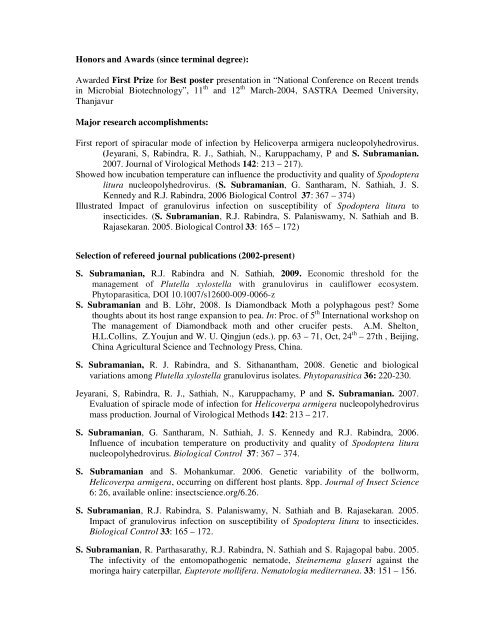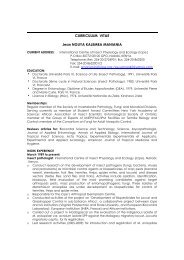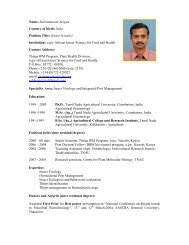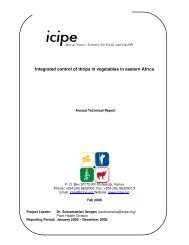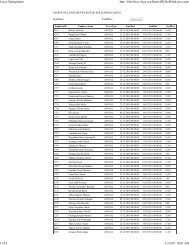Name: Subramanian Sevgan Country of birth: India Position ... - icipe
Name: Subramanian Sevgan Country of birth: India Position ... - icipe
Name: Subramanian Sevgan Country of birth: India Position ... - icipe
You also want an ePaper? Increase the reach of your titles
YUMPU automatically turns print PDFs into web optimized ePapers that Google loves.
Honors and Awards (since terminal degree):<br />
Awarded First Prize for Best poster presentation in “National Conference on Recent trends<br />
in Microbial Biotechnology”, 11 th and 12 th March-2004, SASTRA Deemed University,<br />
Thanjavur<br />
Major research accomplishments:<br />
First report <strong>of</strong> spiracular mode <strong>of</strong> infection by Helicoverpa armigera nucleopolyhedrovirus.<br />
(Jeyarani, S, Rabindra, R. J., Sathiah, N., Karuppachamy, P and S. <strong>Subramanian</strong>.<br />
2007. Journal <strong>of</strong> Virological Methods 142: 213 – 217).<br />
Showed how incubation temperature can influence the productivity and quality <strong>of</strong> Spodoptera<br />
litura nucleopolyhedrovirus. (S. <strong>Subramanian</strong>, G. Santharam, N. Sathiah, J. S.<br />
Kennedy and R.J. Rabindra, 2006 Biological Control 37: 367 – 374)<br />
Illustrated Impact <strong>of</strong> granulovirus infection on susceptibility <strong>of</strong> Spodoptera litura to<br />
insecticides. (S. <strong>Subramanian</strong>, R.J. Rabindra, S. Palaniswamy, N. Sathiah and B.<br />
Rajasekaran. 2005. Biological Control 33: 165 – 172)<br />
Selection <strong>of</strong> refereed journal publications (2002-present)<br />
S. <strong>Subramanian</strong>, R.J. Rabindra and N. Sathiah, 2009. Economic threshold for the<br />
management <strong>of</strong> Plutella xylostella with granulovirus in cauliflower ecosystem.<br />
Phytoparasitica, DOI 10.1007/s12600-009-0066-z<br />
S. <strong>Subramanian</strong> and B. Löhr, 2008. Is Diamondback Moth a polyphagous pest? Some<br />
thoughts about its host range expansion to pea. In: Proc. <strong>of</strong> 5 th International workshop on<br />
The management <strong>of</strong> Diamondback moth and other crucifer pests. A.M. Shelton¸<br />
H.L.Collins, Z.Youjun and W. U. Qingjun (eds.). pp. 63 – 71, Oct, 24 th – 27th , Beijing,<br />
China Agricultural Science and Technology Press, China.<br />
S. <strong>Subramanian</strong>, R. J. Rabindra, and S. Sithanantham, 2008. Genetic and biological<br />
variations among Plutella xylostella granulovirus isolates. Phytoparasitica 36: 220-230.<br />
Jeyarani, S, Rabindra, R. J., Sathiah, N., Karuppachamy, P and S. <strong>Subramanian</strong>. 2007.<br />
Evaluation <strong>of</strong> spiracle mode <strong>of</strong> infection for Helicoverpa armigera nucleopolyhedrovirus<br />
mass production. Journal <strong>of</strong> Virological Methods 142: 213 – 217.<br />
S. <strong>Subramanian</strong>, G. Santharam, N. Sathiah, J. S. Kennedy and R.J. Rabindra, 2006.<br />
Influence <strong>of</strong> incubation temperature on productivity and quality <strong>of</strong> Spodoptera litura<br />
nucleopolyhedrovirus. Biological Control 37: 367 – 374.<br />
S. <strong>Subramanian</strong> and S. Mohankumar. 2006. Genetic variability <strong>of</strong> the bollworm,<br />
Helicoverpa armigera, occurring on different host plants. 8pp. Journal <strong>of</strong> Insect Science<br />
6: 26, available online: insectscience.org/6.26.<br />
S. <strong>Subramanian</strong>, R.J. Rabindra, S. Palaniswamy, N. Sathiah and B. Rajasekaran. 2005.<br />
Impact <strong>of</strong> granulovirus infection on susceptibility <strong>of</strong> Spodoptera litura to insecticides.<br />
Biological Control 33: 165 – 172.<br />
S. <strong>Subramanian</strong>, R. Parthasarathy, R.J. Rabindra, N. Sathiah and S. Rajagopal babu. 2005.<br />
The infectivity <strong>of</strong> the entomopathogenic nematode, Steinernema glaseri against the<br />
moringa hairy caterpillar, Eupterote mollifera. Nematologia mediterranea. 33: 151 – 156.


